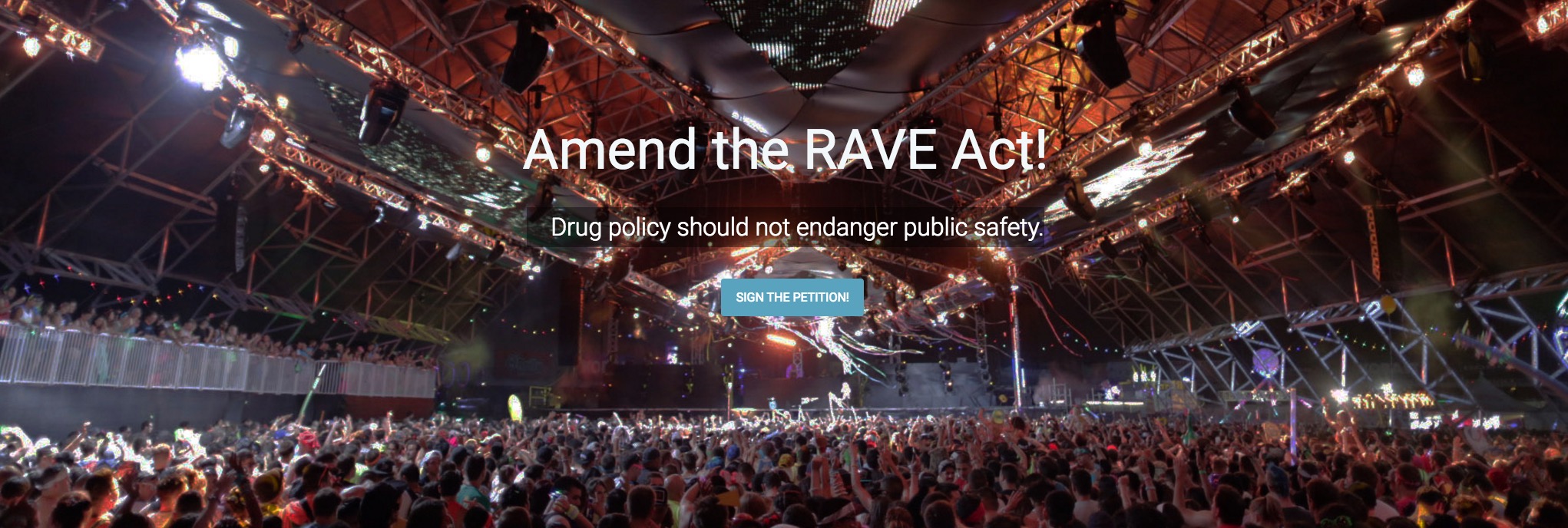Amend the RAVE Act

Last weekend there were three deaths at the Hard Summer Festival in California. The cause of these deaths is not yet confirmed, but the high heat and drug consumption may have contributed.
Last week, the parents of a 19-year-old college student who fatally overdosed on drugs at a rave at the Los Angeles County fairgrounds last August have filed a lawsuit against the event organizers. There have been at least 24 confirmed drug-related deaths nationwide since 2006 among people who went to raves organized by Los Angeles-area companies. (Los Angeles Times)
Did you know event organizers are reluctant to take steps that could help prevent drug fatalities at events? That drug testing services like Dance Safe and The Bunk Police have been banned or shut down at major festivals? The reason is often quoted as the RAVE Act, passed by Congress in 2003.
What does the RAVE Act have to do with the drug overdose problem at events?
What is the Rave Act?
The Reducing American’s Vulnerability to Ecstasy Act, or the RAVE Act, was first introduced by Senator Joseph Biden in 2002 and was passed by Congress the following year.
The RAVE Act expanded earlier “crack house” laws to include commercial venues, allowing business owners to be prosecuted if they “maintain a drug-involved premises.”
When originally passed, the Act gave law enforcement officials greater power to shut down underground dance parties when promoters were knowingly and intentionally encouraging the use of illicit drugs. However, its current language has created a more dangerous situation today by discouraging legitimate EDM concert and festival organizers from enacting common sense safety measures to protect their patrons. Providing free water and air-conditioned rooms, and allowing drug education and other harm reduction services inside their events would save lives. Yet many event organizers are afraid that these actions could be seen as encouraging drug use and therefore subject them to criminal prosecution under the RAVE Act.
What can we do to change this situation?
Amend the RAVE Act!
Dede Goldsmith, whose daughter died at an EDM festival in 2013, started a movement to amend the RAVE Act. She created an informational website and an online petition. Currently, the petition has over 15,000 signatures and it is under review by the Department of Justice. You can learn more and sign the petition at her website Amend the RAVE Act! Please go to her website and sign the petition HERE
Meanwhile, In Europe, drug testing at festivals has recently taken a step forward.
The Secret Garden Party Music Festival in Cambridgeshire, England, made history last weekend by being the first ever UK festival to provide free drug testing to attendees. Close to 200 festival goers opted to have their substances checked before the event even began.
The Loop, a charity group that provides substance testing to festivals and night clubs, provided the testing for this event to promote drug awareness and safety. A 10-minute health and safety session was agreed upon in advance by local police, public health authorities and the interested attendees. Acceptance of this unique service is a milestone as the health and well-being of individuals is slowly being prioritized over strict adherence to outdated drug laws. You can check out the event HERE
Documentary Film ‘What’s in My Baggie”
The following is quoted from THUMP:
“In 2012, Jeff Chambers took two tabs of acid at Bonnaroo. At least, what he thought was acid. What Jeff actually took was called 25I-NBOMe, a dangerous research chemical that has reportedly led to at least 14 deaths in America, according to the DEA.
While wandering around Bonnaroo tripping his face off, Jeff happened to meet a member of The Bunk Police, an organization that hands out drug testing kits at music festivals as part of its mission to promote drug education and “abolish drug dishonesty.” Their Facebook page makes their mission clear: “With the rise of research chemicals comes an equally powerful force… The Bunk Police.”
Chambers and his friends decided to follow The Bunk Police around for five months, going to music festivals around America to document the rise of these dangerous substances.”
You can read the entire article here HERE
You ca learn more about the film “What’s in My Baggie” HERE

Recent Comments